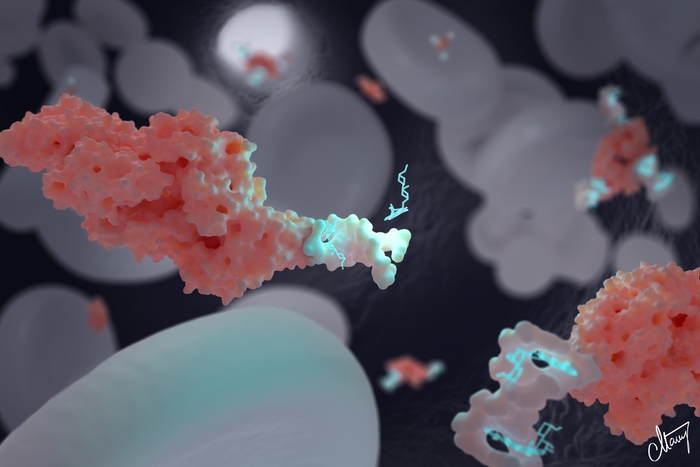博文
DNA“纳米转运蛋白”治疗癌症
 精选
精选
||
DNA“纳米转运蛋白”治疗癌症
诸平
The DNA-based nanotransporter developed by Alexis Vallée-Bélisle and his team can transport and deliver precise concentrations of drugs: in this picture, doxorubicin, a chemotherapeutic drug. These nanotransporters can also be attached to specific biomolecules to optimize drug distribution. Here, we see a nanotransporter (white) attached to albumin (pink) to maintain doxorubin (light blue) in blood circulation. Credit: Illustration : Monney Medical Media / Caitlin Monney
据生物工程师(Bioengineer)网站 2022年11月2日报道,DNA“纳米转运蛋白”治疗癌症(DNA ‘Nanotransporters’ to treat cancer)。
来自加拿大和法国的一组研究人员,设计并验证了一种由比人类头发丝直径小20000倍的DNA制成的新型药物转运蛋白(drug transporters),可以改善癌症和其他疾病的治疗方式。相关研究结果于2022年11月2日已经在《自然通讯》(Nature Communications)杂志网站发表——Arnaud Desrosiers, Rabeb Mouna Derbali, Sami Hassine, Jérémie Berdugo, Valérie Long, Dominic Lauzon, Vincent De Guire, Céline Fiset, Luc DesGroseillers, Jeanne Leblond Chain, Alexis Vallée-Bélisle. Programmable self-regulated molecular buffers for precise sustained drug delivery. Nature Communications, Article Publication Date: 02 November 2022, 13, Article number: 6504. DOI: 10.1038/s41467-022-33491-7. https://www.nature.com/articles/s41467-022-33491-7
参与此项研究的有来自加拿大蒙特利尔大学(Université de Montréal简称UdeM)、加拿大蒙特利尔心脏病研究所(Institut de Cardiologie de Montréal, Canada)、加拿大蒙特利尔迈松纳夫-罗斯芒特医院(Maisonneuve-Rosemont Hospital, Montreal, QC, Canada)以及法国波尔多大学(Univ. Bordeaux, France)的研究人员。
在此项新研究中报道,这些分子转运蛋白可以通过化学编程来提供最佳浓度的药物,使其比目前的方法更有效。
始终保持最佳剂量是一项医学挑战(Optimal dosing at all times: a medical challenge)
成功治疗疾病的关键方法之一是在整个治疗过程中提供并保持治疗药物剂量。次优的治疗暴露会降低效率,通常会导致耐药性,而过度暴露会增加副作用。
保持血液中药物的最佳浓度仍然是现代医学的一大挑战。由于大多数药物会迅速降解,患者被迫(经常忘记)定期服用多剂量。因为每个病人都有不同的药代动力学特征,所以他们血液中的药物浓度差别很大。
蒙特利尔大学(UdeM)化学副教授、仿生纳米技术专家亚历克西斯·瓦利-贝利斯勒(Alexis Vallée-Bélisle)观察到,只有约50%的癌症患者在某些化疗期间获得最佳药物剂量,因此开始探索生物系统如何控制和维持生物分子的浓度。
亚历克西斯·瓦利-贝利斯勒说:“我们已经发现,生物体使用蛋白质转运蛋白,这些转运蛋白被编程以维持甲状腺激素(thyroid hormones)等关键分子的精确浓度,而这些转运蛋白与其分子之间相互作用的强度决定了游离分子的精确浓度。”
这个简单的想法促使拥有加拿大生物工程和生物纳米技术研究(Canada Research Chair in bioengineering and bionanotechnology)主席头衔的亚历克西斯·瓦利-贝利斯勒和他的研究团队开始开发人工药物转运蛋白,以模拟在治疗期间保持药物精确浓度的自然效果。
该研究的第一作者 UdeM 博士生阿诺·德罗齐埃(Arnaud Desrosiers)最初确定并开发了两种DNA转运蛋白:一种用于抗疟药奎宁(quinine),另一种用于治疗乳腺癌和白血病的常用药物阿霉素(doxorubicin)。
然后他证明了这些人工转运蛋白可以很容易地被编程来输送和维持任何特定浓度的药物。
阿诺·德罗齐埃说:“更有趣的是,我们还发现这些纳米转运蛋白(nanotransporters)也可以用作药物储存库,并在治疗过程中使药物剂量最小化,以延长药物的效果。”
他补充说,“这些纳米转运蛋白的另一个令人印象深刻的特点是,它们可以被定向到身体最需要药物的特定部位,原则上应该会减少大部分副作用。”
纳米技术对小鼠的治疗,降低了心脏毒性(Nanotreated mice: reduced cardiotoxicity)
为了证明这些纳米转运蛋白的有效性,研究人员与法国波尔多大学(Université de Bordeaux)的药剂师珍妮·勒布隆-钱恩(Jeanne Leblond-Chain)、UdeM的生物化学家卢克·德格罗塞勒斯(Luc DesGroseillers)、UdeM的病理学家热雷米·伯杜戈(Jérémie Berdugo)、蒙特利尔心脏研究所(Montreal Heart Institute)的药剂师塞利纳·菲塞(Céline Fiset)以及UdeM附属迈松纳夫-罗斯芒特医院(UdeM-affiliated Maisonneuve-Rosemont Hospital)的临床生物化学家文森特·德圭尔(Vincent De Guire)合作。
研究小组使用为阿霉素开发的新型药物转运蛋白,证明了一种特定的药物转运蛋白配方可使阿霉素保持在血液中,并大幅减少其向心脏、肺和胰腺等关键器官的扩散。
在用这种配方治疗的小鼠中,阿霉素在血液中的维持时间延长了18倍,心脏毒性也降低了,使小鼠更加健康,这从它们正常的体重增加中得到了证明。
亚历克西斯·瓦利-贝利斯勒说:“我们的纳米转运蛋白的另一个伟大的特性是它们的高通用性。目前,我们已经演示了这些纳米转运蛋白用于两种不同的药物的工作原理。但由于DNA和蛋白质化学的高度可编程性,人们现在可以设计这些转运蛋白来精确地运送各种治疗性分子。”
此外,他还补充说,“这些转运蛋白还可以与人类设计的脂质体转运蛋白结合,后者目前被用于以不同的速度输送药物。”
血癌的临床研究可否?(A clinical study for blood cancers?)
研究人员现在急于验证他们发现的临床效果。他们相信,由于他们的阿霉素纳米转运蛋白被编程为最佳地保持药物在血液循环中,它可能被用于治疗血癌。
亚历克西斯·瓦利-贝利斯勒说:“我们设想,类似的纳米转运蛋白也可以被开发出来,将药物运送到身体的其他特定位置,并将药物最大限度地存在于肿瘤部位。这将大大提高药物的效率,并减少其副作用。”
这项工作得到了加拿大国家科学和工程研究委员会(National Sciences and Engineering Research Council of Canada through grants RGPIN-2020-06975 and RGPIN-06403)、加拿大研究主席(Canada Reserch Chairs, through grant 950-230012)、加拿大魁北克研究基金(Les Fonds de recherche du Québec—Nature et technologies through grant 2019-PR-256552)、魁北克蛋白质功能、工程和应用研究小组(Le regroupement québécois de recherche sur la fonction, l’ingénierie et les applications des protéines)的资助或者支持。
上述介绍,仅供参考。欲了解更多信息,敬请注意浏览原文或者相关报道。
Unlike artificial nanosystems, biological systems are ideally engineered to respond to their environment. As such, natural molecular buffers ensure precise and quantitative delivery of specific molecules through self-regulated mechanisms based on Le Chatelier’s principle. Here, we apply this principle to design self-regulated nucleic acid molecular buffers for the chemotherapeutic drug doxorubicin and the antimalarial agent quinine. We show that these aptamer-based buffers can be programmed to maintain any specific desired concentration of free drug both in vitro and in vivo and enable the optimization of the chemical stability, partition coefficient, pharmacokinetics and biodistribution of the drug. These programmable buffers can be built from any polymer and should improve patient therapeutic outcome by enhancing drug activity and minimizing adverse effects and dosage frequency.
https://blog.sciencenet.cn/blog-212210-1362189.html
上一篇:研究发现,年轻科学家更勇于创新
下一篇:新材料将使局部可变通的二极管成为可能
